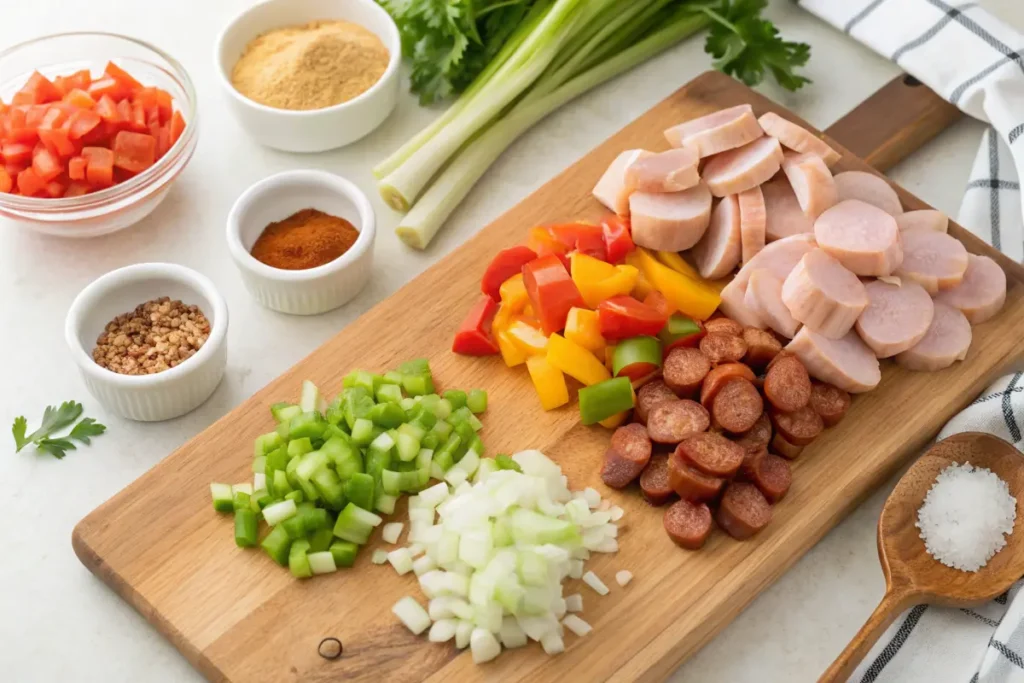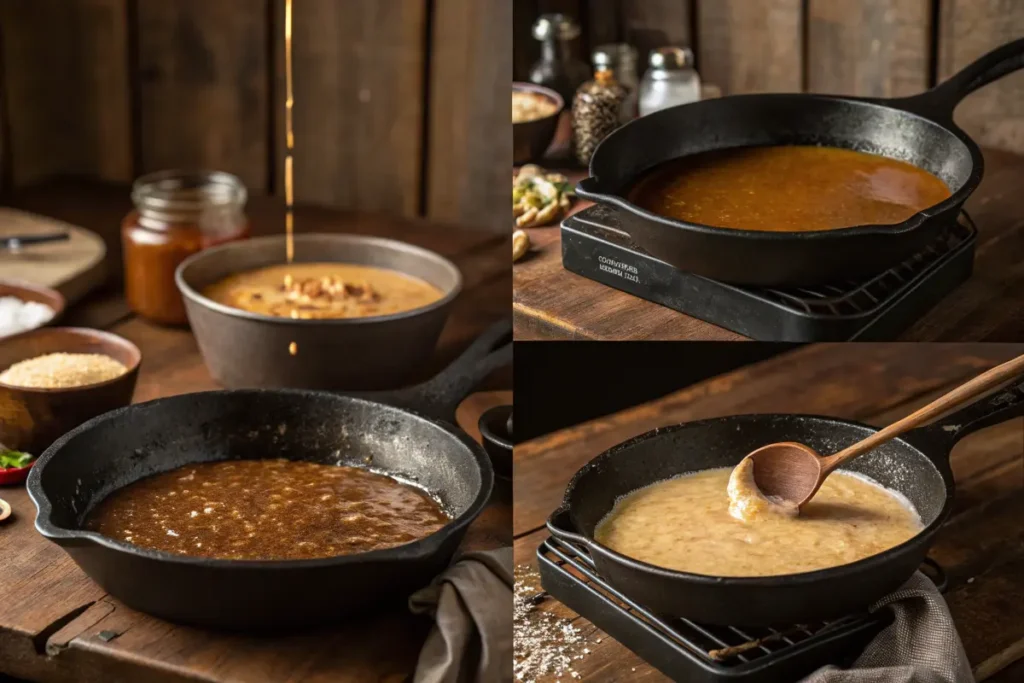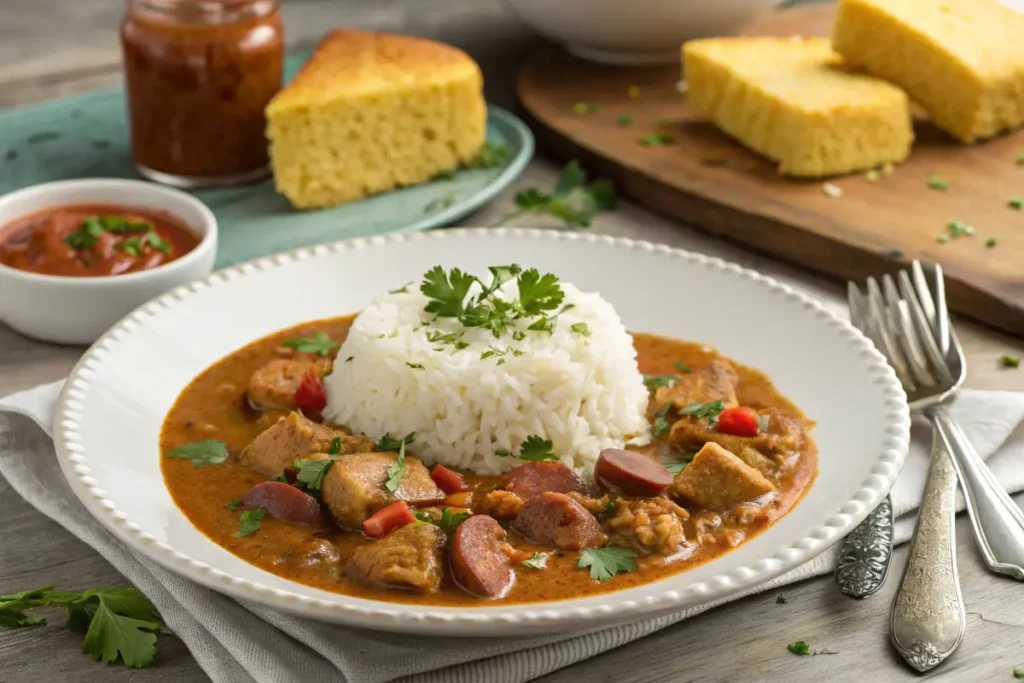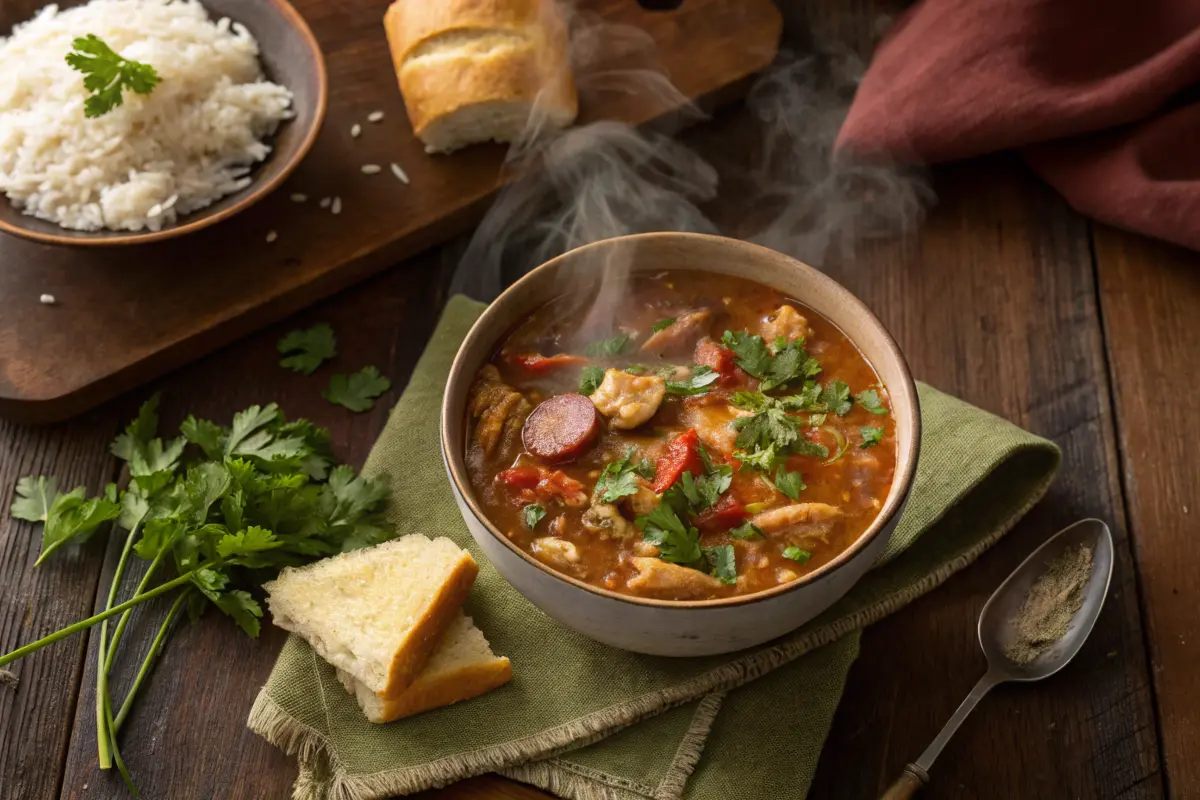Craving something rich, hearty, and packed with flavor? You’re in the right place. In this ultimate guide, we’re diving deep into the world of Cajun Chicken and Sausage Gumbo a true Louisiana classic that warms the soul and satisfies every craving. From its flavorful roots to the magic of the dark roux and the signature blend of spices, this dish is a celebration of Southern comfort and culture. You’ll learn the essentials: the story behind the dish, how to make it like a pro, ingredient swaps, nutritional tips, and even what to serve with it.
Whether you’re a first-timer or a gumbo veteran looking to refine your technique, this guide walks you through it all—step by step. So, grab your favorite pot, let’s stir up something special!
What is Cajun Chicken and Sausage Gumbo?
Origins and Cultural Roots
Gumbo isn’t just food it’s a tradition. Born in the melting pot of Louisiana’s Creole and Cajun communities, this dish reflects a rich cultural fusion of African, French, Spanish, and Native American influences. The word gumbo actually comes from a West African word for okra, one of its earliest thickening agents.
But when it comes to Cajun Chicken and Sausage Gumbo, we’re talking about a down-home, rustic version that’s deeply rooted in the Cajun countryside. Unlike Creole gumbo, which often includes tomatoes and seafood, Cajun gumbo usually skips the tomatoes and leans into darker roux, smoky sausage like andouille, and richly seasoned chicken.
This dish is traditionally made in big pots for family gatherings, holiday feasts, or just a chilly night when you want something warm and filling. It’s more than just soup—it’s history in a bowl.
What Makes It Cajun vs. Creole?
Here’s the scoop: Cajun Chicken and Sausage Gumbo is typically thicker, spicier, and made with fewer ingredients than its Creole cousin. Creole gumbo is city food fancier, with tomatoes and shellfish. Cajun gumbo? That’s country food—built on a dark roux, seasoned chicken, and robust smoked sausage.
It’s slow-cooked, deep-flavored, and not shy with spice. And yes, there’s a lot of love in every stir of that roux.
Core Ingredients Overview: Chicken, Sausage, and the Holy Trinity
At the heart of any good Cajun Chicken and Sausage Gumbo lies a trio of essentials:
- Seasoned chicken (usually thighs for richness)
- Andouille sausage or other smoky links
- The Cajun Holy Trinity: onion, bell pepper, and celery
These ingredients set the stage for a savory, stick-to-your-ribs stew that’s every bit comforting as it is bold. Add in stock, a deep roux, Cajun spices, and a little patience—and you’ve got one unforgettable dish.
Key Ingredients Breakdown
The Cajun Holy Trinity: Onion, Bell Pepper, Celery
Every good gumbo starts with a strong foundation—and nothing screams Cajun more than the Holy Trinity of chopped onion, bell pepper, and celery. These three veggies form the aromatic backbone of the dish, infusing the gumbo with savory depth. When sautéed just right, they create a base that makes your Cajun Chicken and Sausage Gumbo truly sing.
Opt for green bell pepper for that classic bite, and don’t skimp on the onion—yellow works best for sweetness and flavor balance. Add celery last and sauté until it softens slightly. That combo? Absolute magic.
Choosing the Right Chicken: Bone-In vs. Boneless
When it comes to choosing chicken for your gumbo, flavor’s the name of the game. Bone-in, skin-on thighs pack the most punch. They render more fat, deepen the broth, and stay juicy even after hours of simmering.
Boneless thighs work fine for a quicker version, but for a traditional Cajun Chicken and Sausage Gumbo, bone-in delivers the most authentic taste. Chicken breasts tend to dry out, so use them cautiously.
Sausage Matters: Andouille vs. Smoked Sausage
Here’s where things get smoky—literally. Andouille sausage is the classic pick: spicy, coarse-ground, and full of character. If you can’t find it, opt for a smoky kielbasa or a beef sausage with kick. Just make sure it’s fully cooked before slicing and browning.
The browned bits left behind? Keep ‘em. They add layers of flavor to your roux and base.
Stock and Roux: The Flavor Backbone
Don’t underestimate the power of a good stock. Homemade chicken stock is ideal, but a rich, low-sodium store-bought broth works too. Some folks even throw in shrimp stock or bone broth for extra depth.
Then there’s the roux—a browned flour and fat combo that gives Cajun Chicken and Sausage Gumbo its signature richness and body. And we’ll get to that delicious detail next…

Step-by-Step Recipe for Cajun Chicken and Sausage Gumbo
Prepping Your Ingredients Like a Pro
Before you turn on the stove, mise en place everything. Chop your Holy Trinity, slice the sausage, and pat the chicken dry. A bit of prep up front means smoother cooking later—and that’s key with gumbo.
You’ll also want to pre-measure your seasonings. Cajun spice blends usually include paprika, garlic powder, onion powder, thyme, oregano, and a touch of cayenne. Trust us, having this ready helps avoid any last-minute chaos.
How to Make the Perfect Roux (Dark, Nutty, Rich)
This is the heart and soul of your gumbo. Start with equal parts flour and fat (vegetable oil or bacon grease works great). Stir constantly over medium-low heat. And we mean constantly. It’ll feel like forever, but after 20–30 minutes, your roux will turn deep brown think chocolate or mahogany.
Burn it? Start over. A scorched roux ruins the whole batch. But nail it? You’re in for flavor gold.
Sautéing the Trinity and Layering Flavors
Once your roux reaches the perfect color, toss in your Holy Trinity. The veggies will sizzle and steam—this is where the gumbo really comes alive.
Next, stir in your Cajun seasoning, bay leaves, garlic, and sausage slices. Let everything get happy together in that rich base. Deglaze the pot with a splash of stock or water if needed.
Simmering and Skimming: Letting the Gumbo Develop
Add the remaining stock and nestle in your seasoned chicken. Bring it to a boil, then reduce to a gentle simmer. Cover loosely and let it go for about an hour, stirring now and then.
Here’s a trick: skim off any excess oil or foam that rises to the top. This keeps your gumbo from becoming greasy and helps highlight the spices.
Final Touches: Adjusting Seasoning and Thickness
Once the chicken is tender, pull it out, shred or chop it, then return it to the pot. Give your gumbo a final taste test—add salt, hot sauce, or Cajun spice as needed.
Want it thicker? Simmer uncovered for 15 more minutes. Want it thinner? Add a bit more stock.
And if you’re feeling spicy, pair your gumbo with something bold like these Cajun Shrimp Nachos with Cheese Sauce it’s the ultimate flavor bomb duo!

Serving Suggestions and Pairings
Best Side Dishes: Rice, Cornbread, or Potato Salad?
When serving Cajun Chicken and Sausage Gumbo, a big scoop of warm white rice is the classic go-to. It soaks up all the savory goodness and turns the gumbo into a satisfying, stick-to-your-ribs meal.
But don’t stop at rice Southern staples like buttermilk cornbread or potato salad make amazing companions too. Cornbread adds a slightly sweet crunch that plays off the gumbo’s heat, while potato salad gives a cool contrast that balances the richness of the dish.
Some folks even serve gumbo with a scoop of dirty rice or hush puppies. If you’re feelin’ bold, try it with crispy fries or fried okra!
Toppings and Garnishes That Elevate the Dish
A sprinkle of fresh chopped parsley, a few dashes of hot sauce, or even a pinch of filé powder (ground sassafras) can give your Cajun Chicken and Sausage Gumbo that final “wow” factor.
Wanna go all out? Add a slice of crusty French bread on the side to mop up every last bit of that flavorful roux-based broth. Trust us—this combo never fails.
And if you’re throwing a gathering, consider making a Cajun food platter. Something like these spicy Cajun Shrimp Nachos with Cheese Sauce brings extra heat and personality to the table.

Tips, Tricks, and Common Mistakes
How to Avoid Burning the Roux
Roux-making is where many first-time gumbo cooks slip up. The secret? Low and slow. Stir constantly and never leave your pan unattended. If you see black specs or smell a burnt odor, it’s toast start over.
Patience here pays off. That dark, nutty roux flavor is what gives Cajun Chicken and Sausage Gumbo its rich, unforgettable taste.
A cast iron skillet is your friend—it holds heat evenly and keeps things smooth.
Why Your Gumbo May Be Too Oily or Too Thin
Ever ended up with gumbo that’s more grease than gravy? Chances are you added too much oil or didn’t skim enough fat off the top during the simmer. After 45 minutes of cooking, gently skim the surface to remove excess fat and foam.
For a gumbo that’s too thin, simply let it simmer uncovered for an extra 15–20 minutes. Or mix a teaspoon of cornstarch with cool water and stir it in at the end. It’ll thicken things up nicely without affecting flavor.
Flavor Boosters: Filé Powder, Bay Leaves, and More
Want to take your gumbo from good to mind-blowing? Use fresh bay leaves, a dash of Worcestershire sauce, or a touch of smoked paprika. Filé powder, added after cooking, thickens the gumbo and adds earthy flavor.
Bonus tip: Let your gumbo rest for an hour before serving. The flavors meld beautifully and it tastes even better the next day!
Nutritional Facts and Variations
Is Cajun Chicken and Sausage Gumbo Healthy? A Quick Look at Calories and Fat
Let’s be honest—Cajun Chicken and Sausage Gumbo isn’t exactly “light,” but it doesn’t have to be a cheat meal either. Thanks to its protein-rich base and vegetable-heavy foundation, this gumbo can actually be a fairly balanced dish when portioned right.
A typical serving (1.5 cups with rice) clocks in at about 350–450 calories. Most of the fat comes from the roux and sausage, so using leaner cuts of chicken or low-fat sausage can help cut down on grease. You can also reduce the oil in the roux or use whole wheat flour for a subtle health boost.
That said, gumbo is naturally low in sugar and full of spices, which adds big flavor without relying on processed ingredients. Plus, you’re getting fiber from the celery, bell peppers, and onion bonus!
Substitutes and Dietary Versions: Gluten-Free, Keto, Vegetarian
Want to tweak the recipe to fit your lifestyle? No problem.
- Gluten-free: Make the roux with a gluten-free flour blend or arrowroot powder.
- Keto-friendly: Ditch the rice and opt for cauliflower rice. Use extra chicken and sausage while skipping the roux entirely or using almond flour.
- Vegetarian gumbo: Swap the meat for hearty veggies like okra, mushrooms, or eggplant. You can even toss in plant-based sausage for that smoky kick.
No matter your version, you can still enjoy the bold comfort of Cajun Chicken and Sausage Gumbo with just a few thoughtful swaps.
Cajun Gumbo History & Storytelling Angle
The Legacy of Louisiana Cuisine
Gumbo is more than just a dish—it’s a living legacy. Every pot of Cajun Chicken and Sausage Gumbo carries centuries of culture, struggle, and celebration. Born in the bayous of southern Louisiana, gumbo brings together African, French, Spanish, and Native American cooking traditions into one soulful stew.
In the Cajun community, food has always been about survival and simplicity. Settlers made do with what they had wild game, fresh vegetables, homemade stocks, and fiery spices. Over time, these ingredients formed the signature flavors we know today.
When someone serves gumbo, they’re often sharing more than a recipe—they’re sharing a piece of their history.
Gumbo in Family Traditions and Gatherings
Walk into any Southern kitchen during a holiday, and there’s a good chance you’ll smell gumbo bubbling on the stove. From Mardi Gras to Sunday dinners, this dish is a staple at family get-togethers.
And everyone has their own version. Some stir the roux until it’s almost black; others swear by using okra or filé powder. But the heart stays the same—Cajun Chicken and Sausage Gumbo is about warmth, togetherness, and tradition passed down through generations.
So next time you make a pot, know that you’re not just cooking—you’re keeping a story alive.
(FAQ)
What is the secret to a good gumbo?
The magic of Cajun Chicken and Sausage Gumbo lies in the roux. A deep, dark roux builds a strong, savory base. Stir it low and slow until it smells nutty—almost like toasted nuts. Don’t rush it!
Also, layering flavors is key. From browning the sausage to seasoning your stock, every step matters.
How long should gumbo simmer?
Patience pays off. Let your gumbo simmer for at least one hour two if you can. This helps the flavors blend and the chicken to tenderize. The longer it simmers, the better it tastes.
If you have time, refrigerate it overnight and reheat the next day. Many say Cajun Chicken and Sausage Gumbo tastes even better on day two!
Can I freeze Cajun Chicken and Sausage Gumbo?
Absolutely! Gumbo freezes well. Just let it cool completely, then store in airtight containers for up to 3 months. When reheating, thaw overnight and simmer gently to maintain texture and flavor.
What is traditionally served with gumbo?
White rice is the classic sidekick. But cornbread, potato salad, or crusty French bread also pair beautifully. Some even add deviled eggs or fried okra on the side for a Southern-style feast.
Conclusion & Final Thoughts
So there you have it everything you need to make a soul-warming pot of Cajun Chicken and Sausage Gumbo. From the smoky sausage to the bold spices and silky roux, each spoonful tells a story rooted in love, heritage, and flavor.
Whether you’re cooking for family or trying it for the first time, gumbo brings folks together. And that’s the real secret it’s made with heart.
Go ahead, make your own version, and let the pot simmer with memories. And hey, don’t forget the hot sauce.
PrintUltimate Guide to Cajun Chicken and Sausage Gumbo
- Total Time: 1 hour 55 minutes
- Yield: 6 servings 1x
Ingredients
-
1 lb boneless, skinless chicken thighs (or bone-in for richer flavor)
-
12 oz andouille sausage, sliced
-
1 medium yellow onion, diced
-
1 green bell pepper, diced
-
2 stalks celery, diced
-
1/2 cup all-purpose flour
-
1/2 cup vegetable oil
-
4 cups chicken stock
-
2 tsp Cajun seasoning
-
2 bay leaves
-
1/2 tsp garlic powder
-
Salt and black pepper, to taste
-
Cooked white rice, for serving
-
Fresh parsley, chopped (for garnish)
-
Hot sauce (optional)
Instructions
-
In a heavy pot, heat oil over medium-low heat. Add flour and stir continuously for 20–30 minutes until it becomes a deep brown roux.
-
Stir in onion, bell pepper, and celery. Cook until softened, about 5–7 minutes.
-
Add sliced sausage and garlic powder. Cook until sausage is slightly browned.
-
Pour in chicken stock gradually while stirring. Add bay leaves, Cajun seasoning, salt, and pepper.
-
Add chicken thighs and bring to a boil. Reduce to simmer and cover.
-
Let simmer for 60–75 minutes, stirring occasionally.
-
Remove chicken, shred it, and return it to the pot. Simmer uncovered for 15 more minutes.
-
Serve hot over rice, garnished with parsley and hot sauce.
Notes
-
You can substitute chicken thighs with drumsticks or boneless breast.
-
For gluten-free, use a GF flour blend for the roux.
-
Tastes even better the next day!
- Prep Time: 25 minutes
- Cook Time: 1 hour 30 minutes
- Category: Dinner
- Cuisine: Southern, Cajun
Nutrition
- Calories: 420 kcal
- Sugar: 3g
- Sodium: 870mg
- Fat: 25g
- Saturated Fat: 6g
- Carbohydrates: 20g
- Fiber: 2g
- Protein: 26g
- Cholesterol: 85mg

